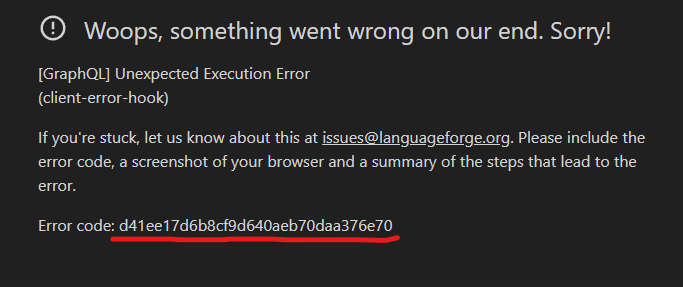Lexbox Language Depot replacement
Repo Structure
- backend - contains dotnet api
- frontend - contains svelte
- hasura - contains hasura metadata
- hgweb - contains hgweb Dockerfile and config
- otel - contains open telemitry collector config
- deployment - contains k8s config for staging and prod
files related to a specific service should be in a folder named after the service. There are some exceptions:
LexBox.slnvisual studio expects the sln to be at the root of the repo and can make things difficult otherwise
Other files, like docker-compose.yaml, should be at the root of the repo, because they're related to all services.
Development
Prerequisites
- docker and compose
- enable Kubernetes in the Docker Desktop settings
Setup
- install Taskfile
- windows:
winget install Task.Task - linux:
sudo snap install task --classicor other options on their website - mac:
brew install go-task/tap/go-task - via npm:
npm install -g @go-task/cli
- windows:
- install Skaffold add it to your path
- clone the repo
- run setup
task setup
Extra setup steps for Windows
If you're running Windows, you may need to add the following lines to your C:\Windows\system32\drivers\etc\hosts file:
127.0.0.1 resumable.localhost
127.0.0.1 hg.localhost
On Linux, anything with a .localhost domain is automatically mapped to 127.0.0.1 so you don't need to edit your /etc/hosts file.
Optional setup for debugging
If you want to test out Honeycomb traces, you will need to set the HONEYCOMB_API_KEY environment variable in
the deployment/dev/local.env file.
You can get the key from here
git note
this repo uses a ignore revs file. To configure this repo to use it run this command. It should be executed as part of task setup
git config blame.ignoreRevsFile .git-blame-ignore-revsfor local dev also:
- node version 18+
- dotnet 7 sdk
Docker workflow
task upThe full app will be running on http://localhost after everything starts. There are some additional urls below to access specific parts of the system.
Local workflow
you can run the front and back end together (console output will be mixed) or in different terminals. All necessary infrastructure (task infra) will be started automatically.
frontend
task uibackend
task apiboth
task devpnpm should be installed automatically using nodejs corepack, if not you can run corepack enable to install it.
Helpful urls
- http://localhost - k8s ingress
- http://localhost:3000 - sveltekit frontend
- http://localhost:5158/api/swagger - swagger docs for the api
- http://localhost:5158/api/graphql/ui - graphiql UI
- http://localhost:5158/api/graphql - graphiql endpoint
- http://localhost:8088/hg - hg web UI add the project code and use the url in FLEx to clone
- http://localhost:1080 - maildev UI
Seeded data
Once the database is created by the dotnet backend, it will also seed some data in the database.
The following users are available, password for them all is just pass:
- admin@test.com: super admin
- manager@test.com: project manager
- editor@test.com: project editor
- user@test.com: user without any projects
There will also be a single project, Sena 3. There will not be an hg repository however, see optional setup below if this is desired.
Hasura workflow
In order to modify Hasura table relations and permissions in hasura we need to use the hasura console. We first will need to install the hasura cli from here and add it to your path.
Next we need to run the following command from the root of the repo:
hasura console --project hasuraThis should open a window in the browser. You will need hasura running in docker for this to work.
Once you make some changes in the console you should notice some metadata under hasura/metadata has been updated, you will want to check that in to git.
Hasura troubleshooting
Sometimes Hasura can get out of sync with the database.
To troubleshoot this you should open the hasura console at localhost:8081 and navigate to settings > metadata status.
If you see some errors there try reloading your metadata on the Metadata Actions tab.
It may be that dotnet did not apply migrations yet,
so you might try restarting dotnet and wait for it to update the database schema.
Then come back and reload the metadata again.
Diagram
flowchart TD
Chorus --> lexbox-api
subgraph lexbox pod
lexbox-api --> otel
end
lexbox-api --> hgweb
lexbox-api --> hgresumable
subgraph hg pod
hgweb
hgresumable
end
hgweb --> hg[hg file system]
hgresumable --> hg
lexbox-api --> hg
ui["ui (sveltekit)"] --> lexbox-api
lexbox-api ---> db[(postgres)]
More info on the frontend and backend can be found in their respective READMEs:
Operational environment
Staging
flowchart LR
FLEx -- "https:(hg-staging|resumable-staging)" --- proxy
Web -- https://staging.languagedepot.org --- proxy([ingress])
proxy ---|http:5158/api or /hg| api([lexbox-api])
proxy ---|http:3000| node([sveltekit])
api -- postgres:5432 --- db([db])
db -- volume-map:db-data --- data[//var/lib/postgresql/]
api -- http:8088/hg --- hgweb([hgweb])
hgweb -- /var/hg/repos --- repos
api -- /hg-repos --- repos
api -- http:80 --- hgresumable([hgresumable])
hgresumable -- /var/vcs/public --- repos
hgresumable -- hgresumable-cache --- cache[//var/cache/hgresume/]
node <-->|http:5158/api & email| api
api -- gRPC:4317 --- otel-collector([otel-collector])
proxy ---|http:4318/traces| otel-collector
node -- gRPC:4317 --- otel-collector
Analytics
This project is instrumented with OpenTelemetry (OTEL). The exported telemetry data can be viewed in Honeycomb.
Traces can be accessed directly with a URL like this: https://ui.honeycomb.io/sil-language-forge/environments/[test|staging|prod]/trace?trace_id=_TRACE_ID_. Yes, bookmark it!
In the application, a trace ID (aka "Error code") shown at the bottom of an error message can be Ctrl+clicked to navigate to the trace in Honeycomb.
